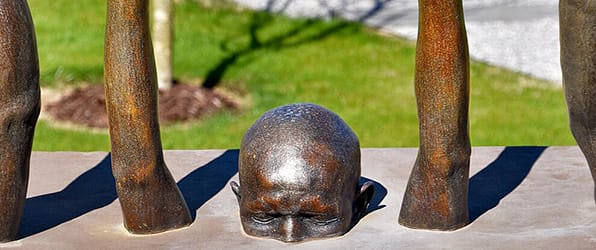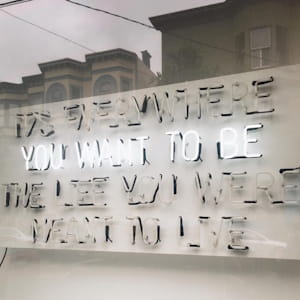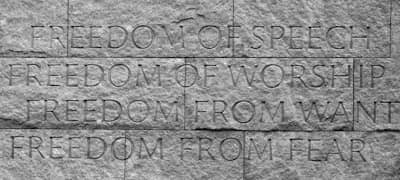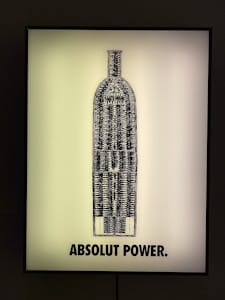Summary of Hank Willis Thomas
Combining skills as a photographer with a deep interest in visual culture and history, Thomas became known through artworks that provide a new take on familiar imagery, such as a corporate logo, in order to interrogate how photography, systemic racism, and the commodification of Black bodies have been intertwined in American consumer culture. In addition to photography, Thomas has also expanded his practice into sculpture and mixed-media installation. In all of his work, Thomas prompts the viewer to look again at the visual culture that saturates everyday life in order to reveal latent meanings and histories.
Accomplishments
- Thomas has an canny ability to use mass culture imagery to evoke painful historical resonances. With a contemporary sensibility, his visually spare yet hard-hitting works confront the viewer with the historical legacy of slavery in America.
- Thomas developed a distinctive visual language that combines elements of advertising, popular culture, and historical references. His use of symbols, text, and found images is not only visually striking but also thought-provoking, making his art accessible and engaging to a broad audience.
- In his public artworks Thomas zooms in on images and symbols important to African-American history, making Black experience-centered monuments that also remind the viewer of the ongoing struggle for equal rights and opportunities for Black Americans.
The Life of Hank Willis Thomas

Thomas sees his role as a visual culture archeologist. "I am interested," he said, "in the ways that popular imagery informs how people perceive themselves and others around the world."
Important Art by Hank Willis Thomas
Branded Head
This work comes from Thomas' series Branded (2003). Using digital editing software, he superimposed the Nike "swoosh" logo onto body parts of Black men, such as on a bald scalp here. Thomas considers this series to be his "first major creative epiphany." The series alludes to the past branding of slaves in the American South, at the same time as they question the dominance of corporate brands in contemporary culture and the way in which we as consumers brand ourselves. Says the artist, "I started thinking about logos as our generation's hieroglyphs. They can be embedded with so much meaning, and I really wanted to play off that." Through this series, the artist explores not only advertising in general, but also the way in which African-American men have been used as tools to sell products, and how they themselves become objectifiable through "the marketing of the black body as commodity," writes Krista Thompson. The branded, raised skin may furthermore evoke keloids and scars on the skin of slaves due to whippings as seen in historical photographs.
The use of black and white in depicting Black bodies may draw comparisons to photographs by Robert Mapplethorpe in the 1980s or by Carl Van Vechten in the early twentieth century. In their cases, however, the photographers were white, and there was an element of a voyeuristic and objectifying gaze on the Black male bodies depicted. By zooming into a particular detail, Thomas's works undercut the possibility of erotic investment and instead bring more to light the objectification of the body in a modern graphic design language. The image's black and white print especially brings out what Thompson has described as "the shiny surface of the Black body as the site of objecthood."
A later, two-part series by Thomas titled Unbranded continues a similar thematic exploration. Unbranded: Reflections in Black by Corporate America 1968-2008 focuses on advertisements featuring Black individuals from the period between Martin Luther King Jr.'s assassination and Barack Obama's election as President of the United States. Meanwhile, Unbranded: A Century of White Women 1915-2015 features advertisements featuring white women, covering a century at the start of which women in America were unable to vote, to the present moment. Like Branded, the works in these series are intended to prompt viewers to question what is really being sold in each image, and, as the artist puts it, "to think more deeply about how advertising reinforces generalizations surrounding race, gender, and cultural identity."
LightJet Print - Cantor Fitzgerald Gallery, Haverford College, Haverford, Pennsylvania
Question Bridge: Black Males
Thomas developed this project in collaboration with artists Chris Johnson, Bayeté Ross Smith, and Kamal Sinclair. The group used video to record Black men of all ages and backgrounds asking questions that they wished to pose to other Black men around the country, such as "Do you really feel free?" and "How do you know when you become a man?" The men were then recorded answering each other's questions. The footage was edited into a video installation. The project was intended "to create honest expression and healing dialogue among members of a particular group," reflecting Thomas's longstanding interest in exploring and giving space to non-stereotypical Black male subjectivities. The artists explain that they wanted "to break down the negative perceptions people have about Black males." They explain that "American media rarely shows whole, complex and authentic images of Black men, so by creating a space where these images can live, we hope that people will start to see things differently." The use of the video-mediated format was intended to "[reduce] the stress of normal face-to-face conversations and [make] people feel more comfortable with expressing their deeply held feelings on topics that divide, unite, and puzzle."
Question Bridge was not Thomas' first foray into dialogic art-making. In 2011, he started a project called In Search of the Truth (The Truth Booth), which is a "roving, inflatable [booth] in the shape of a cartoon word bubble with 'TRUTH' in bold letters on its side," intended to function as a mobile video confessional. Visitors enter the booth, and begin speaking with the phrase "The truth is..." and completed that sentence with whatever was on their mind; many people chose to reflect on their identities. Like Question Bridge, the work uses art as a platform for others' voices. Their participatory and latent political and social expression aspects align with relational art by political artists such as Tania Bruguera.
Multichannel video installation - The Smithsonian National Museum of African American History and Culture, Washington D.C.
If the Leader Only Knew
This work comes from Thomas's sculptural series Punctum (2014). All works in the series were inspired by photographs that Thomas found in twentieth-century German archives. The title of the series, Punctum, refers to a term introduced by French theorist Roland Barthes to describe a precise detail in a photograph that strikes a deep chord in the viewer (or, as Barthes put it, "A photograph's punctum is the accident that pricks me"). From selected photos, Thomas picked out only the hands and arms in each image and recreated them as sculptures (he would repeat this motif of abstracted arms for his 2023 public sculpture, The Embrace). In If the Leader Only Knew, all we see is a length of barbed wire being grasped by several small, child-sized hands. This scene was taken from a photograph of a concentration camp during the Holocaust.
By isolating the hands and rendering them anonymous, however, Thomas also opens up more possible readings all while pointing to a shared theme of liberties and bodily autonomy (or lack thereof). As critics have noted, the works can be understood to evoke other "racialized histories of internment," including slavery in the United States, as well as the ongoing issue of racially disproportionate imprisonment in the country.
Bronze - Nasher Museum of Art at Duke University, Durham, North Carolina
All Power to All People
All Power to All People is a monumental, twenty-eight-foot tall, 7000 lb. sculpture that takes the form of an afro pick, whose handle is a clenched fist (recognizable as the "Black Power salute" popularized during the 1960s civil rights movement). The artist wanted to create a public monument specifically for an African-American audience. He explains the choice of the subject matter: "The Afro pick exists today as many things to different people: it is representative not only of an era but a sound and a counter-culture. It is a uniting motif, worn as adornment, a political emblem, and signature of collective identity," referring to the 1960s, the Civil Rights movement, as well as the positive reclamation of African-American cultural objects and identity. His sculpture, says Thomas, "serves to highlight ideas related to community, strength, perseverance, comradeship, and resistance to oppression." The piece was directly inspired by Swedish artist Claes Oldenburg, who, according to Thomas, "could take any quotidian object, such as a garden spade or badminton birdie, and monumentalize it." Rather than Oldenburg's more Pop art approach to everyday objects, however, Thomas's work draws out the historical and cultural significance of an object as a way to assert his identity.
On public monuments in today's context, : "[They] have a higher charge now. They can celebrate a specific individual, or a group of people, but they should also invite a broader conversation about how a memorial can connect to the rest of the world and represent its people." Thomas has made other public sculptures and monumental works as well, such as his bronze History of the Conquest (2017) which depicts a child holding a bow and reins while riding a snail (intended as a "critique of the prejudiced, historical depictions of people of African descent").
Bronze - Thomas Paine Plaza, Philadelphia, Pennsylvania
Colonialism and Abstract Art
In this artwork made for the Museum of Modern Art, Thomas re-imagines one of the most recognizable charts in the history of modern art: "Cubism and Abstract Art" drawn by the influential former director of the Museum of Modern Art, Alfred H. Barr Jr., in 1936. The original chart streamlined different artistic influences and movements from the late 19th century to the early 20th century to arrive at the emergence of Cubism and, eventually, Abstract Art, presented as an apotheosis. The chart served as a founding story for MoMA's collections and became the backbone of the modern art history that was taught to successive generations of artists and students. While the category of "Negro sculpture" was mentioned in the chart, no other acknowledgments of African art and traditions - and the dynamics of colonialism and empire that had enabled the appropriation of African aesthetics in Western modern art - were mentioned. Thomas's chart filled in these omissions with specific geopolitical contexts especially relating to the Congo and the history of colonial occupation and extraction of resources there. (The Congo serves as a case study that is emblematic of a wider historical phenomenon in the continent).
Compared to the original chart by Barr, Thomas's will strike any viewer right away as much busier and more complicated, reflecting the actual messiness and interrelated factors behind any cultural production and history. It may perhaps even raise doubt about the possibility of such a streamlined narrative in the first place. In terms of art historical scholarship, the work aligns with more recent acknowledgments and explorations of global racial dynamics, colonialist and post-colonialist conditions, and, most importantly, the understanding that any historical narrative is invested with a particular ideology depending on who's telling the story, from what subject position, and to what end.
Graphic design distributed as PDF file - Museum of Modern Art
Liberty (Blue)
In this work, Thomas took old striped U.S. prison uniforms (which were more common at the start of the twentieth century) and refashioned them into a quilt that looks like a maze. Closer examination of the maze reveals the title of the work, "Liberty," embedded within the composition. The word "INMATE" is visible along the top right edge and again along the bottom left edge. This work comes from the series Another Justice, which includes other quilted pieces made from prison uniforms and American flags. The idea for the series came about when Thomas recognized that the stripes in prison uniform "have the same size stripe as many American flags." He says, "I couldn't help but make that correlation between the stars and bars and the bars that people live in all around the country." He goes on to explain that "I just started thinking about how complex our society is, where keeping people behind bars is a business and it's a business that certain people take pride in and certain people make a lot of money off of." Thomas then decided on the maze motif in order to "remind myself and others of the complicated pathways we have to navigate to get to walk these ideals."
Arts writer Dream McClinton notes that the works in Another Justice look at "how incarceration, like slavery, is sewn into the fabric of the United States both metaphorically and literally. Cotton, picked from the hands of enslaved Africans and African-Americans, became a symbol of oppression, now worn on the backs of their descendants, who are trapped into the same peculiar institution." Indeed, as scholars have noted, the prison industrial complex that has been typical of the United States in the past century to the present can be understood as an extension of slavery, with practices, systems, and laws in place that allow for the continued subjugation and control of Black bodies. Artist and critic Jody Zellen recognizes the timeliness of this work, asserting that, "In a tense and potentially change-filled moment in history - burdened by a pandemic, continued racial tensions, and the effects of climate change - the artist employs American symbols to undermine what they supposedly represent."
Mixed media including U.S. prison uniforms - Kayne Griffin Gallery, Los Angeles, California
Biography of Hank Willis Thomas
Childhood
Born in New Jersey, Thomas grew up in New York City surrounded by the arts. His father, Hank Thomas, is a jazz musician, and his mother, Deborah Willis, is a photographer and curator. As a child, he would often accompany his mother to work at the Schomburg Center for Research in Black Culture in Harlem. Thomas spent a great deal of time in archives and developed a passion for re-purposing and re-interpreting old visual materials.
Thomas recalls, "I had such a wonderful, awesome upbringing because I grew up in a place where, what we now refer to as Black excellence, was everywhere." Indeed, in New York he was witness to the golden age of subway graffiti and hip-hop emceeing (Master of Ceremonies), as well as to a generation of Black artists, such as filmmaker Spike Lee and the band Fishbone, who were defining what author Trey Ellis calls a "new Black aesthetic." In Ellis's definition, the new aesthetic expanded the boundary of Black art beyond stereotypical images of Africa and jazz, opening up new possibilities for younger artists. Within his parents' artistic and intellectual circles, Thomas witnessed countless examples of Black individuals rising above the roles expected of them in white America. On the other hand, outside of the artistic sphere, he also saw social issues and incarceration disproportionately affecting African-Americans.
Education and Early Training
Thomas earned a B.F.A. in Photography and Africana studies from New York University in 1998. He then went to the West Coast, where he earned concurrent M.A. and M.F.A. degrees in Photography and Visual Criticism from the California College of the Arts in 2004.
In the year 2000, Thomas experienced a major loss in his family when his cousin, Songha Willis, was murdered during an armed robbery outside a nightclub in Philadelphia. At the funeral, Thomas took a photograph of mourners, which he then edited and turned into a work called Priceless #1 (2004). The work mimicked MasterCard's well-known "Priceless" advertising campaign. Thomas superimposed the MasterCard logo and the text: "3-piece suit: $250, new socks: $2, 9mm Pistol: $80, Bullet: ¢60, Picking the perfect casket for your son: priceless" over the photograph. Making this work, he said, was the moment he "stopped being a photographer and became an artist." Priceless #1 is an example of what the artist calls "photoconceptualism," in which photography becomes a means through which to comment on contemporary conditions. The term references Conceptual Art, an artistic movement started in the 1960s that prioritizes ideas and the interrogation of linguistic signs in art.
One of the most important influences on Thomas was his own mother. Deborah Willis worked tirelessly to recuperate and publicize the work of forgotten Black photographers in history. Her work as a researcher and curator helped fill gaps in knowledge, undoing erasure and showing the vagaries of art historical narratives depending on who's doing the telling. The understanding of art history and visual culture as subject to power and racism undergirds Thomas's approach to artmaking, leading him to dig deep conceptually with each project.
Mature Period

In 2005, Thomas participated in a much-anticipated group show called Frequency at the Studio Museum in Harlem. He exhibited Branded Head (2003), which references Nike's advertising campaign in order to question the use of Black male bodies in US commodity culture. Frequency puts Thomas's name firmly on the map as a key contemporary voice making work that interrogates race and representation in US history. From then on he continued to garner critical praise, leading to teaching jobs at renowned art and photography programs in the US and beyond.
Thomas's use of advertising visual language draws from a 1980s precedent by feminist artist Barbara Kruger, who was also active in New York City. Kruger pioneered the use of sharp, pithy text, like advertising copy, imposed onto eye-catching images in order to make social commentary. In the contemporary context, his use of text to explore Black identities and histories puts his work in dialogue with another important African-American artist, Glenn Ligon, who uses text as a conceptual gambit in his paintings. Both drew on precedents in Conceptual Art but added references to racial histories and identities in their works, Ligon drawing more on literature and Thomas on mass media.
In 2008 Thomas won the first Aperture West Book Prize given by the well-regarded photography magazine Aperture. The award recognized his monograph Pitch Blackness (2008), which provides an overview of his oeuvre up to that point, "chart[ing] his career as he grapples with the issues of grief, black-on-black violence in America and the ways in which corporate culture is complicit in the crises of black male identity."

In 2016, Thomas, along with artists Eric Gottesman, Wyatt Gallery, and Michelle Woo, founded For Freedoms, an artist-based, "anti-partisan" organization that creates spaces and opportunities for "civic engagement, discourse and direct action." This takes place in the form of exhibitions, installations and billboard campaigns, and other public programs across all fifty states and Puerto Rico. In 2023, Thomas's public sculpture, The Embrace, was unveiled in the Boston Common. Depicting intertwined arms, the work abstracts from an iconic photograph of the embrace between Coretta Scott King and Martin Luther King Jr, after the latter had won the Nobel Peace Prize in 1964. Thomas's entry was chosen out of 126 submissions. With this permanent outdoor sculptural piece garnering much media coverage, the artist reached a new level of public prominence. Of the work, Thomas said: "You never wake up and think you'd be able to contribute meaningfully to the legacy of Dr. Martin Luther King and Coretta Scott King [...] And that alone, the fact that I was able to be a part of that, is just humbling and dumbfounding."
Throughout his career, Thomas has maintained a close and mutually supportive creative relationship with his family, whom he considered as his close collaborators. He reflected: "Friendship and collaboration are chosen in a way family isn't. [...] I learned and absorbed so much from my mom's work, and from my dad - friendship comes into our relationship by our choosing to continue collaborating beyond that early influence." He is married to Rujeko Hockley, assistant curator at the Whitney Museum of American Art, with whom he also exchanged creative ideas. With Hockley, Thomas said, they "have a shared language of our chosen crafts." They had a daughter in 2019. Thomas and his family currently live in Brooklyn, New York.
The Legacy of Hank Willis Thomas

While conceptually complex, the vast majority of Thomas' works are characterized by simple elegance in form. His object-based practice (such as his quilts and sculptures) draws influence from, and carries on the legacy of, earlier African-American artists, writers, and intellectuals, like Jacob Lawrence, Faith Ringgold, and Trey Ellis. Meanwhile, he is pioneering in his use of newer dialogic and participatory art forms to generate active discourse amongst members of Black communities across the United States.
Though still quite early in his career, Thomas has shown and expanded the formal and conceptual possibilities for artworks that interrogate the history of Blackness in America, the lived realities of today's Black Americans, and the symbols of "liberty" and "Americanness" that are so strongly revered in the nation's visual culture. As curator Sara Krajewski puts it, "In both his solo work and his collaborations, Thomas asks us to reframe our perceptions of race, politics, history, and popular culture so that we can better understand and combat the systems that dehumanize us." Thomas said: "I'm interested in finding new ways of revealing things that are kind of latent in a given image." In engaging with framing, context, and the position of the viewer, Thomas questions how artistic value and judgment are created by "the institutional work assigned to the frame," as art historian Huey Copeland puts it. In this regard, writes art historian Krista Thompson, his work can be situated within a tradition of Black artmaking that engages with the "frame," both metaphorically and literally, from Lorraine O'Grady's Art Is (1983) to the work of contemporary painter Kehinde Wiley and Mickalene Thomas.
Influences and Connections

-
![Jacob Lawrence]() Jacob Lawrence
Jacob Lawrence -
![Faith Ringgold]() Faith Ringgold
Faith Ringgold -
![Roland Barthes]() Roland Barthes
Roland Barthes -
![Claes Oldenburg]() Claes Oldenburg
Claes Oldenburg - Deborah Willis
- Chris Johnson
- Bayeté Ross Smith
- Kamal Sinclair
-
![Conceptual Art]() Conceptual Art
Conceptual Art -
![Identity Art and Identity Politics]() Identity Art and Identity Politics
Identity Art and Identity Politics -
![Documentary Photography]() Documentary Photography
Documentary Photography -
![Pop Art]() Pop Art
Pop Art ![Appropriation Art]() Appropriation Art
Appropriation Art
- Chris Johnson
- Bayeté Ross Smith
- Kamal Sinclair
 Ask The Art Story AI
Ask The Art Story AI




















